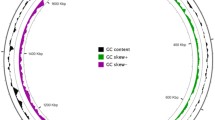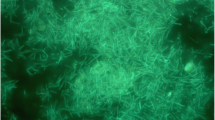Abstract
In the present study, we report the draft genome sequence of an obligate thermophile Geobacillus thermoleovorans strain RL isolated from Manikaran hot water spring located atop the Himalayan ranges, India. Strain RL grew optimally at 70 °C but not below 45 °C. The draft genome (3.39 Mb) obtained by Illumina sequencing contains 138 contigs with an average G + C content of 52.30%. RAST annotation showed that amino acid metabolism pathways were most dominant followed by carbohydrate metabolism. Genome-wide analysis using NCBI’s Prokaryotic Genome Annotation Pipeline revealed that strain RL encodes for a cocktail of industrially important hydrolytic enzymes glycoside hydrolase, α-and β-glucosidase, xylanase, amylase, neopullulanase, pullulanase and lipases required for white biotechnology. In addition, the presence of genes encoding green biocatalyst multicopper polyphenol oxidase (laccase) and an anticancer enzyme l-glutaminase reflects the significance of strain RL in gray and red biotechnology, respectively. Strain RL is a thermophilic multi-enzyme encoding bacterium which could be the source for the recombinant production of biotechnologically significant enzymes. In, addition whole cells of strain RL may be used in bioremediation studies.
Similar content being viewed by others
References
Mehta R, Singhal P, Singh H, Damle D, Sharma AK (2016) Insight into thermophiles and their wide-spectrum applications. 3 Biotech 6:81. https://doi.org/10.1007/s13205-016-0368-z
Gupta V, Gupta N, Capalash N, Sharma P (2017) Bio-prospecting bacterial diversity of hot springs in northern Himalayan region of India for laccases. Indian J Microbiol 57:285–291. https://doi.org/10.1007/s12088-017-0656-2
Baltaci MO, Genc B, Arslan S, Adiguzel G, Adiguzel A (2017) Isolation and characterization of thermophilic bacteria from geothermal areas in Turkey and preliminary research on biotechnologically important enzyme production. Geomicrobiol J 34:53–62. https://doi.org/10.1080/01490451.2015.1137662
Bhalla A, Bansal N, Kumar S, Bischoff KM, Sani RK (2013) Improved lignocellulose conversion to biofuels with thermophilic bacteria and thermostable enzymes. Bioresour Technol 128:751–759. https://doi.org/10.1016/j.biortech.2012.10.145
Novik G, Savich V, Meerovskaya O (2018) Geobacillus Bacteria: potential commercial applications in industry, bioremediation, and bioenergy production. In: Growing and handling of bacterial cultures [Working Title]. IntechOpen, p 13, https://doi.org/10.5772/intechopen.76053
Brumm PJ, De Maayer P, Mead DA, Cowan DA (2015) Genomic analysis of six new Geobacillus strains reveals highly conserved carbohydrate degradation architectures and strategies. Front Microbiol 6:430. https://doi.org/10.3389/fmicb.2015.00430
Gerasimova J, Kuisiene N (2012) Characterization of the novel xylanase from the thermophilic Geobacillus thermodenitrificans JK1. Microbiology 81:418–424. https://doi.org/10.1134/S0026261712040066
Liu B, Zhang N, Zhao C, Lin B, Xie L, Huang Y (2012) Characterization of a recombinant thermostable xylanase from hot spring thermophilic Geobacillus sp. TC-W7. J Microbiol Biotechnol 22:1388–1394
Verma D, Satyanarayana T (2012) Cloning, expression and applicability of thermo-alkali-stable xylanase of Geobacillus thermoleovorans in generating xylooligosaccharides from agro-residues. Bioresour Technol 107:333–338. https://doi.org/10.1016/j.biortech.2011.12.055
Anand A, Kumar V, Satyanarayana T (2013) Characteristics of thermostable endoxylanase and β-xylosidase of the extremely thermophilic bacterium Geobacillus thermodenitrificans TSAA1 and its applicability in generating xylooligosaccharides and xylose from agro-residues. Extremophiles 17:357–366. https://doi.org/10.1007/s00792-013-0524-x
Bhalla A, Bischoff KM, Uppugundla N, Balan V, Sani RK (2014) Novel thermostable endo-xylanase cloned and expressed from bacterium Geobacillus sp. WSUCF1. Bioresour Technol 165:314–318. https://doi.org/10.1016/j.biortech.2014.03.112
Teplitsky A, Mechaly A, Stojanoff V, Sainz G, Golan G, Feinberg H, Gilboa R, Reiland V, Zolotnitsky G, Shallom D, Thompson A, Shoham Y, Shoham G (2004) Structure determination of the extracellular xylanase from Geobacillus stearothermophilus by selenomethionyl MAD phasing. Acta Crystallogr Sect D Biol Crystallogr 60:836–848. https://doi.org/10.1107/S0907444904004123
Solomon V, Teplitsky A, Shulami S, Zolotnitsky G, Shoham Y, Shoham G (2007) Structure–specificity relationships of an intracellular xylanase from Geobacillus stearothermophilus. Acta Crystallogr Sect D Biol Crystallogr 63:845–859. https://doi.org/10.1107/S0907444907024845
Potprommanee L, Wang XQ, Han YJ, Nyobe D, Peng YP, Huang Q, Liu JY, Liao YL, Chang KL (2017) Characterization of a thermophilic cellulase from Geobacillus sp. HTA426, an efficient cellulase-producer on alkali pretreated of lignocellulosic biomass. PLoS ONE 12:e0175004. https://doi.org/10.1371/journal.pone.0175004
Sharma A, Schmidt M, Kiesel B, Mahato NK, Cralle L, Singh Y, Richnow HH, Gilbert JA, Arnold W, Lal R (2018) Bacterial and archaeal viruses of Himalayan hot springs at Manikaran modulate host genomes. Front Microbiol 9:3095. https://doi.org/10.3389/fmicb.2018.03095
Sharma A, Kohli P, Singh Y, Schumann P, Lal R (2016) Fictibacillus halophilus sp. nov., from a microbial mat of a hot spring atop the Himalayan range. Int J Syst Evol Microbiol 66:2409–2416. https://doi.org/10.1099/ijsem.0.001051
Mahato NK, Tripathi C, Verma H, Singh N, Lal R (2014) Draft genome sequence of Deinococcus sp. strain RL isolated from sediments of a hot water spring. Genome Announc 2:e00703-14. https://doi.org/10.1128/genomeA.00703-14
Sharma A, Hira P, Shakarad M, Lal R (2014) Draft genome sequence of Cellulosimicrobium sp. strain MM, Isolated from Arsenic-rich microbial mats of a Himalayan hot spring. Genome Announc 2:e01020-14. https://doi.org/10.1128/genomeA.01020-14
Tripathi C, Mishra H, Khurana H, Dwivedi V, Kamra K, Negi RK, Lal R (2017) Complete genome analysis of Thermus parvatiensis and comparative genomics of Thermus spp. provide insights into genetic variability and evolution of natural competence as strategic survival attributes. Front Microbiol 8:1410. https://doi.org/10.3389/fmicb.2017.01410
Dwivedi V, Kumari K, Gupta SK, Kumari R, Tripathi C, Lata P, Niharika N, Singh AK, Kumar R, Nigam A, Garg N, Lal R (2015) Thermus parvatiensis RL(T) sp. nov., isolated from a hot water spring, located atop the Himalayan ranges at Manikaran, India. Indian J Microbiol 55:357–365. https://doi.org/10.1007/s12088-015-0538-4
Dwivedi V, Sangwan N, Nigam A, Garg N, Niharika N, Khurana P, Khurana JP, Lal R (2012) Draft genome sequence of Thermus sp. strain RL, isolated from a hot water spring located atop the Himalayan ranges at Manikaran. India. J Bacteriol 194:3534. https://doi.org/10.1128/JB.00604-12
Sangwan N, Lambert C, Sharma A, Gupta V, Khurana P, Khurana JP, Sockett RE, Gilbert JA, Lal R (2015) Arsenic rich Himalayan hot spring metagenomics reveal genetically novel predator–prey genotypes. Environ Microbiol Rep 7:812–823. https://doi.org/10.1111/1758-2229.12297
Singh DN, Tripathi AK (2013) Coal induced production of a rhamnolipid biosurfactant by Pseudomonas stutzeri, isolated from the formation water of Jharia coalbed. Bioresour Technol 128:215–221. https://doi.org/10.1016/j.biortech.2012.10.127
Goris J, Konstantinidis KT, Klappenbach JA, Coenye T, Vandamme P, Tiedje JM (2007) DNA–DNA hybridization values and their relationship to whole-genome sequence similarities. Int J Syst Evol Microbiol 57:81–91. https://doi.org/10.1099/ijs.0.64483-0
Sood U, Hira P, Kumar R, Bajaj A, Rao DLN, Lal R, Shakarad M (2019) Comparative genomic analyses reveal core-genome-wide genes under positive selection and major regulatory hubs in outlier strains of Pseudomonas aeruginosa. Front Microbiol 10:53. https://doi.org/10.3389/fmicb.2019.00053
Simpson JT, Wong K, Jackman SD, Schein JE, Jones SJ, Birol I (2009) ABySS: a parallel assembler for short read sequence data. Genome Res 19:1117–1123. https://doi.org/10.1101/gr.089532.108
Li H, Durbin R (2009) Fast and accurate short read alignment with Burrows–Wheeler transform. Bioinformatics 25:1754–1760. https://doi.org/10.1093/bioinformatics/btp324
Tatusova T, DiCuccio M, Badretdin A, Chetvernin V, Nawrocki EP, Zaslavsky L, Lomsadze A, Pruitt KD, Borodovsky M, Ostell J (2016) NCBI prokaryotic genome annotation pipeline. Nucl Acids Res 44:6614–6624. https://doi.org/10.1093/nar/gkw569
Haft DH, DiCuccio M, Badretdin A, Brover V, Chetvernin V, O’Neill K, Li W, Chitsaz F, Derbyshire MK, Gonzales NR, Gwadz M, Lu F, Marchler GH, Song JS, Thanki N, Yamashita RA, Zheng C, Thibaud-Nissen F, Geer LY, Marchler-Bauer A, Pruitt KD (2018) RefSeq: an update on prokaryotic genome annotation and curation. Nucl Acids Res 46:D851–D860. https://doi.org/10.1093/nar/gkx1068
Vieille C, Zeikus GJ (2001) Hyperthermophilic enzymes: sources, uses, and molecular mechanisms for thermostability. Microbiol Mol Biol Rev 65:1–43. https://doi.org/10.1128/MMBR.65.1.1-43.2001
Kalyani D, Tiwari MK, Li J, Kim SC, Kalia VC, Kang YC, Lee JK (2015) A highly efficient recombinant laccase from the yeast Yarrowia lipolytica and its application in the hydrolysis of biomass. PLoS ONE 10:e0120156. https://doi.org/10.1371/journal.pone.0120156
Louime C, Uckelmann H (2008) Cellulosic ethanol: securing the planet future energy needs. Int J Mol Sci 9:838–841. https://doi.org/10.3390/ijms9050838
Beg Q, Kapoor M, Mahajan L, Hoondal G (2001) Microbial xylanases and their industrial applications: a review. Appl Microbiol Biotechnol 56:326. https://doi.org/10.1007/s002530100704
Hii SL, Tan JS, Ling TC, Ariff AB (2012) Pullulanase: role in starch hydrolysis and potential industrial applications. Enzyme Res 2012:921362. https://doi.org/10.1155/2012/921362
Hussein AH, Lisowska BK, Leak DJ (2015) The genus Geobacillus and their biotechnological potential. Adv Appl Microbiol 92:1–48. https://doi.org/10.1016/bs.aambs.2015.03.001
Lee HS, Kim MS, Cho HS, Kim JI, Kim TJ, Choi JH, Park C, Lee HS, Oh BH, Park KH (2002) Cyclomaltodextrinase, neopullulanase, and maltogenic amylase are nearly indistinguishable from each other. J Biol Chem 277:21891–21897. https://doi.org/10.1074/jbc.M201623200
Takata H, Kuriki T, Okada S, Takesada Y, Iizuka M, Minamiura N, Imanaka T (1992) Action of neopullulanase. Neopullulanase catalyzes both hydrolysis and transglycosylation at alpha-(1-4)- and alpha-(1-6)-glucosidic linkages. J Biol Chem 267:18447–18452
Bajaj A, Lohan P, Jha PN, Mehrotra R (2010) Biodiesel production through lipase catalyzed transesterification: an overview. J Mol Catal B Enzym 62:9–14. https://doi.org/10.1016/J.MOLCATB.2009.09.018
Muthukumar NP, Murugan S (2014) Production, purification and application of bacterial laccase: a review. Biotechnology (Faisalabad) 13:196–205
Guo X, Zhou S, Wang Y, Song J, Wang H, Kong D, Zhu J, Dong W, He M, Hu G, Ruan Z (2016) Characterization of a highly thermostable and organic solvent-tolerant copper-containing polyphenol oxidase with dye-decolorizing ability from Kurthia Huakuii LAM0618T. PLoS ONE 11:1–17. https://doi.org/10.1371/journal.pone.0164810
Kunamneni A, Plou FJ, Ballesteros A, Alcalde M (2008) Laccases and their applications: a patent review. Recent Pat Biotechnol 2:10–24
Wang C, Zhang H, Ren D, Li Q, Zhang S, Feng T (2015) Effect of direct-current electric field on enzymatic activity and the concentration of laccase. Indian J Microbiol 55:278–284. https://doi.org/10.1007/s12088-015-0523-y
Patel SKS, Kalia VC, Choi JH, Haw JR, Kim IW, Lee JK (2014) Immobilization of laccase on SiO2 nanocarriers improves its stability and reusability. J Microbiol Biotechnol 24:639–647
Jesuraj SAV, Sarker MMR, Ming LC, Praya SMJ, Ravikumar M, Wui WT (2017) Enhancement of the production of l-glutaminase, an anticancer enzyme, from Aeromonas veronii by adaptive and induced mutation techniques. PLoS ONE 12:e0181745. https://doi.org/10.1371/journal.pone.0181745
Bulbul D, Karakus E (2013) Production and optimization of l-glutaminase enzyme from Hypocrea jecorina pure culture. Prep Biochem Biotechnol 43:385–397. https://doi.org/10.1080/10826068.2012.741641
Sathish T, Prakasham RS (2010) Isolation and identification of l-glutaminase an antileukemic enzyme producing mico-organism from Godavari river bank soils in Andhra Pradesh. Int Res J Pharm 1:367–373
Roy S, Ghosh S, Mallick P, Maity P (2008) Acivicin with glutaminase regulates proliferation and invasion of human MCF-7 and OAW-42 cells—an in vitro study. Indian J Exp Biol 46:22–26
Acknowledgements
This work was supported by a Grant to AKS (SERB N-PDF (PDF/2016/002780). DNS acknowledge Council of Scientific and Industrial Research (CSIR) for providing financial support under CSIR-Senior Research Associate (Pool Scientist’s Scheme). US and VG acknowledge University Grant Commission (UGC) and CSIR, respectively for providing Senior Research Fellowship. CDR is grateful to Dr. Manoj Khanna, Principal, Ramjas College, University of Delhi for his constant support.
Author information
Authors and Affiliations
Corresponding authors
Ethics declarations
Conflict of interest
All authors declare no conflict of interest.
Additional information
Publisher's Note
Springer Nature remains neutral with regard to jurisdictional claims in published maps and institutional affiliations.
Rights and permissions
About this article
Cite this article
Singh, D.N., Sood, U., Singh, A.K. et al. Genome Sequencing Revealed the Biotechnological Potential of an Obligate Thermophile Geobacillus thermoleovorans Strain RL Isolated from Hot Water Spring. Indian J Microbiol 59, 351–355 (2019). https://doi.org/10.1007/s12088-019-00809-x
Received:
Accepted:
Published:
Issue Date:
DOI: https://doi.org/10.1007/s12088-019-00809-x




